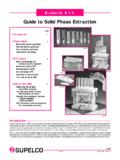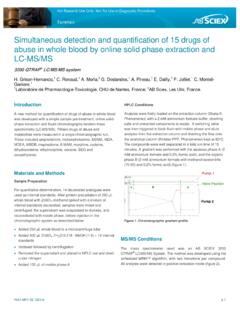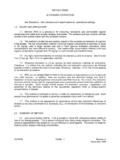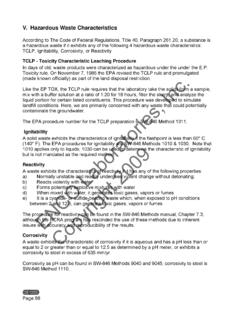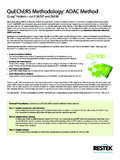Transcription of METHOD 1311 TOXICITY CHARACTERISTIC …
1 CD-ROM1311- 1 Revision 0 July 1992 METHOD 1311 TOXICITY CHARACTERISTIC leaching SCOPE AND TCLP is designed to determine the mobility of both organic andinorganic analytes present in liquid, solid, and multiphasic a total analysis of the waste demonstrates that individualanalytes are not present in the waste, or that they are present but at such lowconcentrations that the appropriate regulatory levels could not possibly beexceeded, the TCLP need not be an analysis of any one of the liquid fractions of the TCLP extract indicates that a regulated compound is present at such high concentra-tions that, even after accounting for dilution from the other fractions of theextract, the concentration would be above the regulatory level for that compound,then the waste is hazardous and it is not necessary to analyze the remainingfractions of the an analysis of extract obtained using a bottle extractor showsthat the concentration of any regulated volatile analyte exceeds the regulatorylevel for that compound, then the waste is hazardous and extraction using the ZHEis not necessary.
2 However, extract from a bottle extractor cannot be used todemonstrate that the concentration of volatile compounds is below the OF METHOD liquid wastes ( , those containing less than dry solidmaterial), the waste, after filtration through a to m glass fiberfilter, is defined as the TCLP wastes containing greater than or equal to solids, theliquid, if any, is separated from the solid phase and stored for later analysis;the particle size of the solid phase is reduced, if necessary. The solid phaseis extracted with an amount of extraction fluid equal to 20 times the weight ofthe solid phase. The extraction fluid employed is a function of the alkalinityof the solid phase of the waste. A special extractor vessel is used when testingfor volatile analytes (see Table 1 for a list of volatile compounds).
3 Followingextraction, the liquid extract is separated from the solid phase by filtrationthrough a to m glass fiber compatible ( , multiple phases will not form on combination),the initial liquid phase of the waste is added to the liquid extract, and theseare analyzed together. If incompatible, the liquids are analyzed separately andthe results are mathematically combined to yield a volume-weighted averageconcentration. VITON is a trademark of Du Pont. 1 CD-ROM1311- 2 Revision 0 July interferences that may be encountered during analysis arediscussed in the individual analytical AND apparatus: The agitation apparatus must be capable ofrotating the extraction vessel in an end-over-end fashion (see Figure 1) at30 + 2 rpm. Suitable devices known to EPA are identified in Table Extraction Vessel (ZHE).
4 This device isfor use only when the waste is being tested for the mobility of volatileanalytes ( , those listed in Table 1). The ZHE (depicted in Figure 2)allows for liquid/solid separation within the device, and effectivelyprecludes headspace. This type of vessel allows for initial liquid/solidseparation, extraction, and final extract filtration without opening thevessel (see Section ). The vessels shall have an internal volume of500-600 mL, and be equipped to accommodate a 90-110 mm filter. The devicescontain VITON O-rings which should be replaced frequently. Suitable ZHE 1devices known to EPA are identified in Table the ZHE to be acceptable for use, the piston within the ZHEshould be able to be moved with approximately 15 psi or less. If it takesmore pressure to move the piston, the O-rings in the device should bereplaced.
5 If this does not solve the problem, the ZHE is unacceptable forTCLP analyses and the manufacturer should be ZHE should be checked for leaks after every extraction. If thedevice contains a built-in pressure gauge, pressurize the device to50 psi, allow it to stand unattended for 1 hour, and recheck the the device does not have a built-in pressure gauge, pressurize thedevice to 50 psi, submerge it in water, and check for the presence of airbubbles escaping from any of the fittings. If pressure is lost, check allfittings and inspect and replace O-rings, if necessary. Retest thedevice. If leakage problems cannot be solved, the manufacturer should ZHEs use gas pressure to actuate the ZHE piston, while othersuse mechanical pressure (see Table 3). Whereas the volatiles procedure(see Section ) refers to pounds per square inch (psi), for themechanically actuated piston, the pressure applied is measured intorque-inch-pounds.
6 Refer to the manufacturer's instructions as to theproper 3 Revision 0 July Extraction Vessel. When the waste is beingevaluated using the nonvolatile extraction, a jar with sufficient capacityto hold the sample and the extraction fluid is needed. Headspace isallowed in this extraction bottles may be constructed from various materials,depending on the analytes to be analyzed and the nature of the waste (seeSection ). It is recommended that borosilicate glass bottles be usedinstead of other types of glass, especially when inorganics are ofconcern. Plastic bottles, other than polytetrafluoroethylene, shall notbe used if organics are to be investigated. Bottles are available from anumber of laboratory suppliers. When this type of extraction vessel isused, the filtration device discussed in Section is used for initialliquid/solid separation and final extract Devices: It is recommended that all filtrations beperformed in a Extractor Vessel (ZHE): When the waste isevaluated for volatiles, the zero-headspace extraction vessel described inSection is used for filtration.
7 The device shall be capable ofsupporting and keeping in place the glass fiber filter and be able towithstand the pressure needed to accomplish separation (50 psi).NOTE:When it is suspected that the glass fiber filter has been ruptured,an in-line glass fiber filter may be used to filter the materialwithin the Holder: When the waste is evaluated for other thanvolatile analytes, any filter holder capable of supporting a glass fiberfilter and able to withstand the pressure needed to accomplish separationmay be used. Suitable filter holders range from simple vacuum units torelatively complex systems capable of exerting pressures of up to 50 psior more. The type of filter holder used depends on the properties of thematerial to be filtered (see Section ). These devices shall have aminimum internal volume of 300 mL and be equipped to accommodate a minimumfilter size of 47 mm (filter holders having an internal capacity of Lor greater, and equipped to accommodate a 142 mm diameter filter, arerecommended).
8 Vacuum filtration can only be used for wastes with lowsolids content (<10%) and for highly granular, liquid-containing other types of wastes should be filtered using positive pressurefiltration. Suitable filter holders known to EPA are shown in Table of Construction: Extraction vessels andfiltration devices shall be made of inert materials which will not leachor absorb waste components. Glass, polytetrafluoroethylene (PTFE), ortype 316 stainless steel equipment may be used when evaluating themobility of both organic and inorganic components. Devices made of highdensity polyethylene (HDPE), polypropylene (PP), or polyvinyl chloride(PVC) may be used only when evaluating the mobility of metals. Borosili- TEDLAR is a registered trademark of Du CD-ROM1311- 4 Revision 0 July 1992cate glass bottles are recommended for use over other types of glassbottles, especially when inorganics are analytes of : Filters shall be made of borosilicate glass fiber, shallcontain no binder materials, and shall have an effective pore size of m, or equivalent.
9 Filters known to EPA which meet these specifications areidentified in Table 5. Pre-filters must not be used. When evaluating themobility of metals, filters shall be acid-washed prior to use by rinsing with 1 Nnitric acid followed by three consecutive rinses with deionized distilled water(a minimum of 1 L per rinse is recommended). Glass fiber filters are fragile andshould be handled with Meters: The meter should be accurate to + units at 25 Extract Collection Devices: TEDLAR bags or glass, stainless 2steel or PTFE gas-tight syringes are used to collect the initial liquid phase andthe final extract of the waste when using the ZHE device. The devices listed arerecommended for use under the following a waste contains an aqueous liquid phase or if a wastedoes not contain a significant amount of nonaqueous liquid ( , <1% oftotal waste), the TEDLAR bag or a 600 mL syringe should be used to collect and combine the initial liquid and solid a waste contains a significant amount of nonaqueousliquid in the initial liquid phase ( , >1% of total waste), the syringeor the TEDLAR bag may be used for both the initial solid/liquid separation and the final extract filtration.
10 However, analysts should use one or theother, not the waste contains no initial liquid phase (is 100%solid) or has no significant solid phase (is 100% liquid), either theTEDLAR bag or the syringe may be used. If the syringe is used, discard the first 5 mL of liquid expressed from the device. The remainingaliquots are used for Extraction Fluid Transfer Devices: Any device capable oftransferring the extraction fluid into the ZHE without changing the nature of theextraction fluid is acceptable ( , a positive displacement or peristalticpump, a gas tight syringe, pressure filtration unit (see Section ), or otherZHE device). Balance: Any laboratory balance accurate to within+ grams may be used (all weight measurements are to be within + grams). or Erlenmeyer flask, glass, 500 5 Revision 0 July , appropriate diameter to cover beaker or stirrer.










